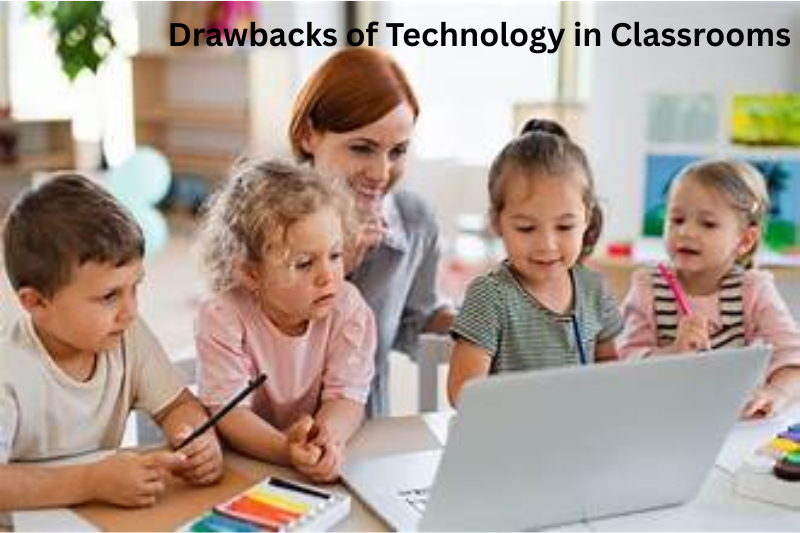Hello! Let’s be honest — the way students learn today is nowhere near what it used to be a decade ago. From chalkboards to smartboards, notebooks to tablets, and libraries to Google, technology in classrooms has completely revolutionized education.
But is all this technology really making learning better? Or is it just a distraction? That’s exactly what we’ll explore today. I’m going to walk you through what technology in classrooms really means, its benefits, drawbacks, and how it’s changing the future of education for teachers and students alike — all in a simple, friendly tone.
What is Technology in Classrooms?

When we talk about technology in classrooms, we’re referring to the use of digital tools, software, and internet resources to support and enhance teaching and learning. This could be anything from:
- Smartboards replacing traditional whiteboards
- Tablets or Chromebooks instead of notebooks
- Online learning platforms like Google Classroom or Moodle
- Apps like Kahoot, Quizizz for interactive quizzes
- Virtual Reality (VR) headsets for immersive lessons
- AI-driven tutoring systems
It’s about making lessons more interactive, accessible, and personalized. Whether it’s a first-grade classroom or a university lecture hall, technology is being integrated into every level of education.
Benefits of Technology in Classrooms
Let’s dig deep into the advantages of technology in classrooms. These are not just buzzwords but actual game-changing benefits you’ll notice in everyday school life.
1. Enhanced Engagement and Interest
- Interactive videos, animations, and simulations make complex topics easier to understand.
- Tools like Kahoot turn boring quizzes into fun games.
- Virtual field trips allow students to explore museums or planets without leaving the classroom.
Example: A history lesson on Ancient Egypt becomes way more exciting when students can explore the Pyramids in 3D through virtual reality.
2. Personalized Learning for Every Student
- Adaptive learning platforms adjust content based on each student’s pace.
- Struggling students get extra practice while advanced students can move ahead.
Example: Khan Academy offers personalized dashboards where students can learn at their own speed, ensuring no one is left behind.
3. Global Access to Information
- Students have access to vast online resources — research papers, eBooks, tutorials, and educational videos.
- Encourages self-learning and curiosity beyond the textbook.
Example: Instead of relying only on a classroom lecture, a student can watch a YouTube tutorial on Algebra for better clarity.
4. Improved Collaboration and Communication
- Group projects are easier with tools like Google Docs, Zoom, or Microsoft Teams.
- Students can collaborate on assignments in real-time, even from home.
Example: A science project team can work on a shared Google Slides presentation while discussing ideas over a video call.
5. Efficient Assessment and Feedback
- Teachers can conduct instant online quizzes, polls, and surveys.
- Immediate feedback helps students know where they stand and what to improve.
Example: Apps like Quizizz allow teachers to create quizzes that auto-grade, saving time and providing instant results to students.
6. Preparation for Future Careers
- Digital literacy is no longer optional.
- Exposure to tech tools prepares students for real-world jobs that require tech-savvy skills.
Example: Learning how to create presentations, use spreadsheets, or code simple programs gives students a head start for the future.
You may also like to read these posts:
Educational Technology Trends: The Complete Guide to The Future of Learning
Best EdTech Tools 2025 – Your Ultimate Guide to Smarter Learning!
Online Learning Platforms: The Future of Education You Can Start Today
AI in Education: Revolutionizing the Way We Learn (Complete Guide
Drawbacks of Technology in Classrooms

While there’s a lot to be excited about, it’s important to also understand the challenges and disadvantages of technology in classrooms.
1. Digital Distractions
- Students might get distracted by social media, games, or unrelated internet browsing.
- Maintaining focus in a tech-rich environment can be tough without proper supervision.
Example: A student with a tablet might sneakily play games or chat during lessons.
2. Overdependence on Technology
- Basic skills like handwriting, mental math, or face-to-face communication may suffer.
- Students might become too reliant on gadgets for simple tasks.
Example: Instead of solving a simple multiplication mentally, a student may reach for a calculator app.
3. Digital Divide: Unequal Access
- Not all students have access to high-end devices or stable internet at home.
- This creates inequality, especially in underprivileged areas.
Example: A student from a remote village may struggle to complete online assignments due to poor internet connectivity.
4. Technical Glitches and Downtime
- Internet failures, software crashes, and hardware issues can disrupt lessons.
- Teachers need backup plans in case technology fails.
Example: A planned online quiz can get canceled if the school’s Wi-Fi stops working unexpectedly.
5. Learning Curve for Teachers
- Not all educators are tech-savvy.
- Training is essential, and adapting to new tools takes time and effort.
Example: A teacher used to traditional teaching methods might find it challenging to use advanced LMS platforms like Moodle or Canvas.
The Role of Teachers in a Tech-Enabled Classroom
Here’s something important to remember: Technology doesn’t replace teachers; it empowers them.
Teachers now play the role of facilitators, guiding students in using digital tools effectively. They curate resources, design interactive lessons, and help students develop critical thinking skills in a digital environment.
But for this to work:
- Teachers need continuous professional development.
- Schools must provide tech training workshops.
- A balance must be maintained between screen-time and traditional learning methods.
The Future of Technology in Classrooms: What’s Next?
Technology in classrooms is evolving rapidly, and we’re just scratching the surface. Here’s what’s coming next:
- Artificial Intelligence (AI) Tutors – AI bots will provide real-time assistance and personalized feedback.
- Augmented Reality (AR) Learning – Visualizing 3D models right on desks using AR apps.
- Gamified Learning Platforms – Entire syllabi designed as engaging games with rewards and leaderboards.
- Cloud-Based Classrooms – Entire classroom resources and lesson plans available on the cloud for seamless learning.
- Global Virtual Classrooms – Students from different countries collaborating in real-time on shared projects.
Conclusion
To sum it up, technology in classrooms is a powerful tool that, when used wisely, can transform education into a more engaging, inclusive, and effective experience. However, it’s essential to maintain a balance. Technology should complement teaching, not overshadow it.
Educators, students, and parents must work together to ensure that technology serves as an enhancer, not a distraction. After all, the ultimate goal of education remains the same — nurturing curious minds and preparing students for a brighter future.
FAQs
Q1: What is the role of technology in classrooms?
Q2: What are the main advantages of using technology in classrooms?
Increased student engagement through interactive content.
Personalized learning paths for different student abilities.
Easy access to global information and resources.
Improved communication and collaboration tools.
Real-time assessments and feedback for quicker progress tracking.
Prepares students with digital skills for future careers.
Q3: What are the disadvantages of technology in classrooms?
Students may get distracted by non-educational apps and games.
Over-reliance on devices can weaken basic skills like handwriting.
Not all students have access to devices or stable internet (digital divide).
Technical issues like software glitches and connectivity problems can disrupt learning.
Teachers may require ongoing training to keep up with evolving tech.







